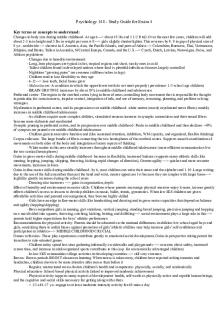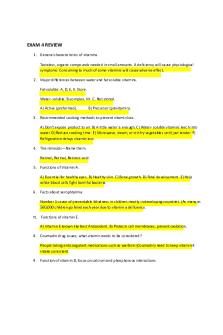Nutrition Exam 4 - this is a study guide with all you need to pass the exam. PDF

| Title | Nutrition Exam 4 - this is a study guide with all you need to pass the exam. |
|---|---|
| Author | Andre Dos Santos |
| Course | Essentials of Human Nutrition |
| Institution | Miami Dade College |
| Pages | 4 |
| File Size | 89.9 KB |
| File Type | |
| Total Downloads | 57 |
| Total Views | 155 |
Summary
this is a study guide with all you need to pass the exam....
Description
EXAM 4 REVIEW 1. General characteristics of vitamins. Tasteless, organic compounds needed in small amounts. A deficiency will cause physiological symptoms. Consuming to much of some vitamins will cause adverse effect. 2. Major differences between water and fat soluble vitamins. Fat-soluble: A, D, E, K. Store. Water- soluble: B-complex, Vit. C. Not stored. A) Active (preformed).
B) Precursor (previtamin).
3. Recommended cooking methods to prevent vitamin loss. A) Don’t expose product to air. B) A little water is enough. C) Water- soluble vitamins leech into water. D) Reduce cooking time. E) Microwave, steam, or stir-fry vegetables until just tender. F) Refrigeration delays vitamin loss. 4. The retinoids—Name them. Retinol, Retinal, Retinoic acid. 5. Functions of Vitamin A. A) Essential for healthy eyes. B) Healthy skin. C) Bone growth. D) Fetal development. E) Help white blood cells fight harmful bacteria. 6. Facts about xerophtalmia. Number 1 cause of preventable blindness in children mostly in developing countries. (As many as 500,000 children go blind each year due to vitamin a deficiency. 7. Functions of vitamin E. A) Vitamin E known like best Antioxidant. B) Protects cell membranes, prevent oxidation. 8. Coumadin drug issues; what vitamin needs to be considered? People taking anticoagulant medications such as warfarin (Coumadin) need to keep vitamin K intake consistent. 9. Function of vitamin D, focus on calcium and phosphorous interactions
A) Cholesterol containing compound skin is converted to inactive form of vitamin D. B) Vitamin D in food is also an inactive form. C) Regulates two important bone minerals, calcium, and phosphorus. D) Stimulates intestinal absorption of CA and P to maintain healthy blood levels and build and maintain bones. E) May prevent type 2 Diabetes and some type of Cancer. 10. Aspects of Rickets. On the rise in U.S. due to decreased milk consumption, other factors. The bones of children with rickets aren’t adequately mineralized with calcium and phosphorus, causing them to weaken and leading to bowed legs. 11. The B vitamins as a whole, common role. Act as coenzyme in energy metabolizing. 12. Vitamin deficiency names (specific). A) Stunting: Lack of Vitamin A. B) Rickets: Vitamin D deficiency disease. C) Osteomalacia: Adult equivalent of Rickets. D) Beri Beri: Loss of appetite, memory, and weigh. E) Pellagra: Naicin deficiency disease (diarrhea, dementia, death). F) Pernicious anemia: B12 deficiency. 13. Niacin action at 40 times the UL. Sometimes prescribed in high doses (40 times UL) by physicians to decrease blood LDL cholesterol and triglycerides, also increase HDL. Daily needs, Men: 14mg. Women: 16mg. 14. Possible consequences of Folate deficiency during pregnancy Can result in neutral tube birth defects. Ex: spina bifida, anencephaly. 15. Food sources of Folate. Enriched grains (Rice, Pasta, Breads, Cereals), legumes, broccoli, asparagus, leafy greens sush as spinach. 16. Folates interactions with other vitamins. Too much folic acid can mask deficiency of B12. Can lead to macrocytic Anemia. 17. Know all aspects/general characteristics of vitamin B12. Also called Cobalamine because it contains the element Cobalt. Requires intrinsic factor, protein made in stomach to be absorbed in the small intestine. Pernicious Anemia results in people who cannot make intrinsic factor, treatment requires B12 injections. Symptoms may take years to appear. 18. General characteristics, functions of Vitamin C
Function: coenzyme to synthesize and use certain amino acids. Needed to make collagen, must abundant protein in body, present in connective tissue. Important for healthy bones, skin, blood, vessels and teeth. Acts as antioxidant and helps immune system. Helps absorb iron from plants foods. Breaks down histamine, cause of inflammation. 19. How do antioxidants work? By neutralized free radicals. 20. How does the body maintain fluid balance? (could be all of above) Electrolytes: Minerals that help maintain fluid balance. Thirst mechanism. Antidiuretic hormone. 21. Functions of water in the body. Acts as universal solvent and a transport medium. Helps maintain body temperature. Is a lubricant for eyes, joints. (Could be all of above) 22. What factors can affect a person’s fluid needs? Daily water needs vary depending on physical activity, environmental, and gender. (could be all of above). 23. General characteristics of minerals. Inorganic. Minerals have varying bioavailability (how easy absorb). 24. Sodium sources. About 77% of sodium consumed by Americans is from processed foods. 25. Fruit/veg intake and potassium adequacy. Potassium: Minimum of 7 servings/day will meet potassium needs. 26. Hypertension risk factors. Reduce your sodium intake. Lose excess weight. Stay physically active. Drink alcohol moderately. Follow the DASH diet. 27. Functions of calcium and phosphorous. Calcium: Helps build strong bones and teeth. Plays a role in muscles, nerves and blood. May help lower high blood pressure. May fight colon cancer. May reduce risk of kidney stone. May reduce risk of obesity. Phosphorous: Needed for bones and teeth (assist calcium) 28. Forms of iron and their charactistics.
A) Heme iron: from animal sources. B) Non-heme iron: in plant foods, but increased by ascorbic acid. 29. Iron sources. Food sources: Iron-enriched bread and grain products; heme-iron in meats, fish and poultry 30. Iodine deficiency, early signs. Early sign of deficiency = goiter (enlarged thyroid gland). Iodine deficiency during early stages of fetal development can cause cretinism. 31. Digestion of fat-soluble vitamins.
32. Facts about carotenoids.
33. Vitamin K forms. A) Menaquinone synthesized by intestinal bacteria. B) Phylloquinone founds in green plants, essential for blood clotting. 34. Vitamin C, Echinacea, zinc and the common cold—what does research show?
35. Bottled vs. tap water.
36. What does the USP seal of approval on supplements indicate? Indicates quality and safety. 37. Fluid content of foods...
Similar Free PDFs

Nutrition Final Exam Study Guide
- 11 Pages

Final exam study guide nutrition
- 11 Pages

Nutrition Study Guide Exam 1
- 15 Pages

Nutrition Final Exam Study Guide
- 54 Pages

Exam 4 Study Guide
- 22 Pages

EXAM 4 study guide
- 15 Pages

Study Guide Exam 4
- 8 Pages

Exam 4 Study Guide
- 4 Pages

Study guide exam 4
- 6 Pages

Exam 4 Study Guide
- 5 Pages
Popular Institutions
- Tinajero National High School - Annex
- Politeknik Caltex Riau
- Yokohama City University
- SGT University
- University of Al-Qadisiyah
- Divine Word College of Vigan
- Techniek College Rotterdam
- Universidade de Santiago
- Universiti Teknologi MARA Cawangan Johor Kampus Pasir Gudang
- Poltekkes Kemenkes Yogyakarta
- Baguio City National High School
- Colegio san marcos
- preparatoria uno
- Centro de Bachillerato Tecnológico Industrial y de Servicios No. 107
- Dalian Maritime University
- Quang Trung Secondary School
- Colegio Tecnológico en Informática
- Corporación Regional de Educación Superior
- Grupo CEDVA
- Dar Al Uloom University
- Centro de Estudios Preuniversitarios de la Universidad Nacional de Ingeniería
- 上智大学
- Aakash International School, Nuna Majara
- San Felipe Neri Catholic School
- Kang Chiao International School - New Taipei City
- Misamis Occidental National High School
- Institución Educativa Escuela Normal Juan Ladrilleros
- Kolehiyo ng Pantukan
- Batanes State College
- Instituto Continental
- Sekolah Menengah Kejuruan Kesehatan Kaltara (Tarakan)
- Colegio de La Inmaculada Concepcion - Cebu





